Abstract
This study reviewed the benefits of outdoor activities and educational programs that take place in nature in terms of the cognitive and mental development of children. Research has highlighted the benefits offered to children by their participation in experiential activities that take place outdoors and are related to natural phenomena. These activities help children realize how important it is to conserve nature and protect sites of world heritage, thus becoming active citizens in the future. In this study, the uniqueness of Syros Island is presented, emphasizing the need for the world-renowned geological heritage of Syros to be preserved and promoted, both for the scientific community and for the public, with the aim of establishing a geopark in Apano Meria, as proposed by local authorities, along with a local museum. In this context, a working methodology was developed involving the design and implementation of a pilot educational program combining field-based activities, guided interpretation, and interactive learning tools. An indicative educational program was piloted with primary and secondary school students, as well as postgraduate students from the University of Athens. Recognizing the important role of geoparks in school education, the program focused on the rare geological phenomena on the northern side of Syros and was adapted to the characteristics of each participant age group.
1. Introduction
Learning does not always take place in a classroom (formal education). Field trips to museums, parks, forests, zoos, botanical gardens, or any kind of geological site are some of the most typical informal learning environments [1]. The reason for this is that outdoor environments and nature provide the context in which theory and practice are integrated [2]. If scientific content is to be taught, a naturalistic, experiential approach through structured learning will lead to better results [3]. Wells [4] states that a child’s ability to focus on and perceive natural phenomena will be enhanced by daily exposure to natural environments.
The island of Syros, in the central Aegean Sea, happens to host some of the most distinguished and well-preserved rock formations. For this reason, in recent years, significant efforts have been made to include the area in the UNESCO Global Geoparks Network, as the island’s unique geological history is revealed through its exceptional, preserved, and easily accessible tectonic structures and mineral assemblages. These geological features are indicative of a subduction-related geotectonic environment, providing invaluable information on the function and evolution of our planet [5]. Thus, the island is an ideal subject for geoconservation and geoeducation. The realization of this fact was the reason for the design and implementation of organized educational activities where learning will take place outdoors, so that students will have the opportunity to experience practical geological phenomena and processes.
The purpose of this paper is to highlight the benefits that children gain from educational programs related to nature and the geological and ecological wealth of a region, with the aim of presenting an educational museum program based on raising students’ awareness of geoheritage, with particular emphasis on the area of Ano Meria on Syros Island.
In recent years, the promotion of geological heritage through the creation of geoparks and ecological museums has gained more and more attention. Geoparks are aimed not only at geoconservation but also at promoting the public’s understanding of geological phenomena, even by people without a geoscientific background [6]. UNESCO World Geoparks promote research in the geosciences and prioritize environmental education as a key objective [7,8].
On the other hand, museums—and especially ecomuseums—play a critical role in preserving socio-cultural and geological identity [9]. Their purpose extends beyond mere exhibition; they function as educational and community-oriented institutions that enhance cultural continuity, encourage sustainable tourism practices, and contribute to the well-being of local communities.
Extensive research has demonstrated that outdoor education programs significantly enhance children’s observational skills, creativity, imagination, critical thinking, and overall cognitive, socio-emotional, and motor development [10,11,12,13,14]. Through direct interaction with nature, children learn by doing, according to the theory of biophilia, which proposes an innate human affinity with the natural world [15,16].
Spending time outdoors not only reduces stress and improves psychological well-being [17,18] but also cultivates a lifelong sense of environmental stewardship. Environmental education, particularly when introduced early in school curricula, plays a vital role in fostering this awareness [19,20]. Engaging children in hands-on activities in the natural environment provides irreplaceable opportunities for experiential learning, far beyond what even the most advanced classroom technologies can offer [21].
The proposal presented in this paper is based on a museological framework that emphasizes community participation and education, following the principles of the New Museology introduced in the late 1970s [22]. Moving beyond the traditional role of museums as repositories of objects, New Museology redefined museums as socially sensitive, democratic institutions that promote accessibility, participation, and public engagement.
This shift aligns with the International Council of Museums (ICOM)’s 2022 definition of a museum as a not-for-profit, permanent institution serving society by researching, interpreting, and promoting tangible and intangible heritage [23]. In this context, museums are tools for education, reflection, and community empowerment.
The concept of the ecomuseum, as envisioned by Georges-Henri Rivière and Hugues de Varine [24,25], embodies these principles by actively involving local populations in preserving and interpreting their natural and built environment. Ecomuseums aim to improve community well-being and foster sustainable development through culture, education, environmental action, and social cohesion.
Moreover, this approach complements ideas from feminist urbanism, which advocate for the design of inclusive, community-driven public and natural spaces that address the inequalities produced by patriarchal and capitalist urban planning (Figure 1) [26,27]. The ecomuseum model, by promoting local initiatives and collective action, offers a framework for creating such equitable and supportive environments.
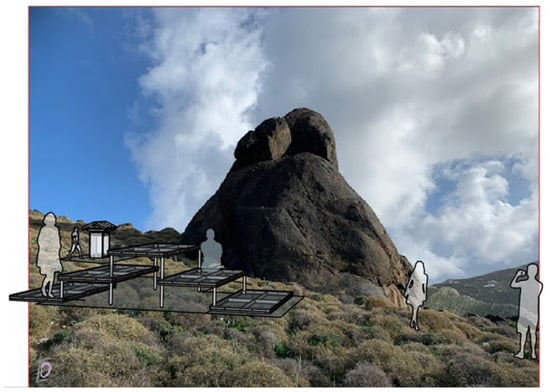
Figure 1.
A feminist urbanism approach to design in the outdoor space of Aerolithos (a geosite in Apano Meria, Syros). Points of gentle activity and comfortable resting areas that do not alter the landscape, with seating accommodating more than one visitor, and an information kiosk with visual materials that allow people to interact and learn.
2. Materials and Methods
Syros (Figure 2) belongs to the Cyclades complex, which essentially consists of peaks of submerged mountains that extend southeast from mainland Greece in a circular arrangement around the sacred island of Delos. The complex lies between 38°05′ and 36°20′ north latitude and 24° to 26° east longitude and is bordered by the Myrtoan Sea to the west, the Icarian and South Aegean Seas to the east, the Cretan Sea to the south, and the Central Aegean Sea to the north.

Figure 2.
A. Sketch map of Greece indicating the location of the Cyclades Plateau. B. Satellite photo of the Cyclades Plateau, indicating the location of Syros Island.
Syros consists primarily of the Cycladic Blueschist Unit (CBU), which is globally important due to its high-pressure, low-temperature (HP-LT) metamorphic rocks, including eclogites and blueschists (Figure 3). These rocks, formed through the subduction of the Pindus oceanic crust beneath the Eurasian Plate about 80 million years ago, have attracted extensive international research in petrology, structural geology, and geochronology [5,28,29,30,31,32].
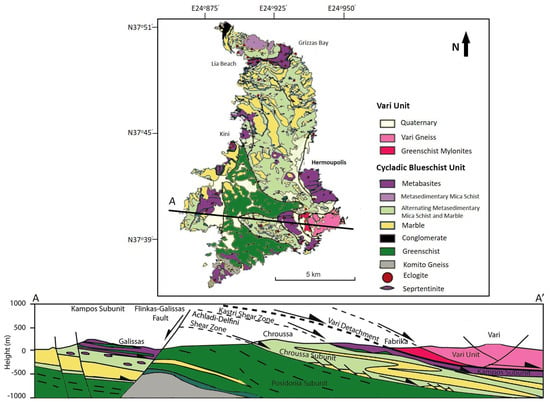
Figure 3.
Geological map and cross-section of Syros Island [33,34,35,36,37].
The northern part of Syros, known as Apano Meria, offers excellent exposures of these HP-LT rocks. The area is a key location for the study of both plate subduction and exhumation processes in convergent tectonic settings. The eclogites, which appear as rounded, dark-colored rocks derived mainly from metagabbros, and the cyanoschists were metamorphosed under extreme conditions of high pressure and relatively low temperatures during subduction to depths of up to 50 km and subsequent exhumation.
This unique geological history, spanning more than 170 million years from the Mesozoic to the Tertiary, has placed Syros at the center of international tectonic studies. The island’s formations vividly demonstrate fundamental mechanisms of global plate tectonics, making it a natural heritage site worthy of preservation and protection.
Based on this geological importance, the local community of Syros wishes and strives for the establishment of a geopark in Apano Meria. The aim is to include the island in the UNESCO Global Network of Geoparks [9].
According to Zouros [8], a geopark should have geological sites of high scientific quality, rarity, aesthetic attractiveness, and educational value. The Syros geopark aspires to raise public awareness for the protection of the Earth’s geological heritage while promoting sustainable development and environmental education. Key elements include the organization of educational programs at all levels, hosting educational activities, and the creation of a special geological museum, closely linked to geotourism and heritage initiatives.
An educational program was designed using geological evidence from Apano Meria. It introduces participants to Syros’s unique rocks in an engaging way while emphasizing the cultural and environmental importance of geoparks. The program promotes critical thinking, environmental awareness, and ecological responsibility.
Using Bloom’s taxonomy (knowledge, comprehension, application, analysis, synthesis, and evaluation) [36] and the principles of “learning by doing” [37,38], the program employs a mystery game format, resembling a treasure hunt. Participants follow clues, solve problems, and search for a “blue diamond,” while learning about geological processes and rock formation. Experiential and inquiry-based learning approaches have been shown to effectively enhance engagement and knowledge retention in environmental education [39,40]. These activities encourage observation, comparison, creation, and synthesis. Creative tasks help participants connect the geological history of the rocks to local heritage and culture. The program concludes with an evaluation activity (Figure 4).
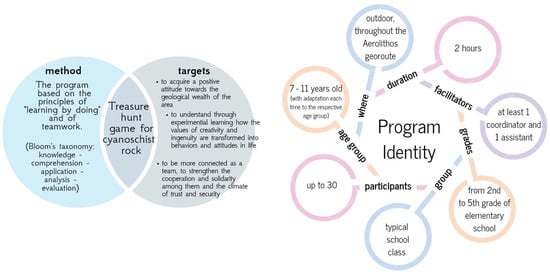
Figure 4.
Educational philosophy scheme followed during the museum program’s design.
The program was adapted to different audiences and settings.
It was first implemented for postgraduate students of the “Museum Studies” program at the University of Athens during the “Museum Education” course in December 2021 (13 participants), February 2024 (14 participants), and June 2024 (12 participants). Prior lectures introduced ecomuseums and case studies of ecomuseum projects in Europe and worldwide, in alignment with museum education strategies for informal learning environments [41], followed by workshops on audience-specific program design.
In February 2023, the program was carried out for students from the 5th Primary School of Ermoupolis (37 students from the fourth and sixth grades) and the local Vocational High School (EPAL) in Syros (29 students) at the Aerolithos geosite.
In October 2023, the Research Centre for Museum Studies presented an interactive version at the Athens Science Festival, including a life-sized video projection of Aerolithos rock and educational films enhanced with augmented reality (Figure 5).
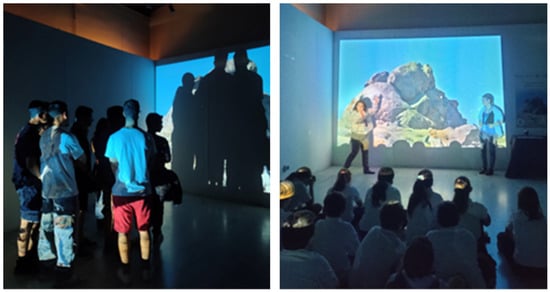
Figure 5.
Interactive video installation exhibit at the Athens Science Festival 2023.
The program was designed for flexibility, allowing adjustments based on location, age group, and conditions (Appendix A).
For example, at Kampos-Aerolithos, which lacks an indoor exhibition space, the final activity included dramatizations and a trust-building game. A kinetic activity referencing the history of Gyaros Island, formerly a site of exile, was added, with participants re-enacting historical events. High school programs incorporated scientific terminology and Morse code for added complexity, while primary school activities emphasized creativity and basic geological concepts. Adapting activities to participants’ developmental stages and learning preferences has been recommended in the environmental and outdoor education literature [42,43]. These dynamic adaptations ensured the program met the needs and expectations of different participant groups.
Evaluation was integrated into all program contexts using activities based on Bloom’s taxonomy and post-program discussions where possible. Graduate student groups participated in structured reviews (Appendix B), while time limitations at the Athens Science Festival led to the use of a standardized questionnaire. Program evaluation practices in non-formal education contexts were guided by works such as Stufflebeam’s CIPP model (2003) and recent studies on evaluating experiential learning in geosciences [44,45].
From over 1000 participants, 635 complete responses were collected: 66 from Syros school students, 27 from university students, and 542 from the Athens Science Festival (519 students and 23 teachers). The feedback guided program refinements to maintain alignment with educational goals and participant needs.
The ages of the respondents at the Athens Science Festival corresponded to primary and secondary education students. Among primary school respondents, approximately 80% were in the fourth grade or higher, while within the secondary education group, roughly 60% were junior high school students and 40% were high school students. In terms of gender distribution, participation was balanced, with a slight majority of female respondents (approximately 55%) across both educational levels.
The questionnaire was administered in Greek, tailored to be age-appropriate for the participating students. It was reviewed by a team of educators and museum staff to ensure clarity, comprehension, and suitability for both primary and secondary school audiences. An English translation of the questionnaire is provided in Appendix B for reference.
For the analysis of responses, descriptive statistics were used for the closed-ended questions. Open-ended responses were processed qualitatively to identify recurring words and themes. Word clouds were created to visually represent the frequency of key terms in the students’ answers, using the online tool https://www.wooclap.com/en/word-cloud-generator/ (accessed on 28 February 2024), which generates word clouds based on word frequency algorithms. Diagrams were generated using Microsoft Excel to present quantitative results in graphical form.
3. Results
3.1. Evaluation of the Program by Students on Syros Island
Students on Syros Island (Figure 6) evaluated the educational program. According to the feedback, most students (63 respondents) confirmed that they had acquired knowledge about the geology of Apano Meria, with only a few (3 respondents) providing different answers (Figure 7). This result demonstrates the program’s effectiveness in improving participants’ understanding of the region’s geological features.
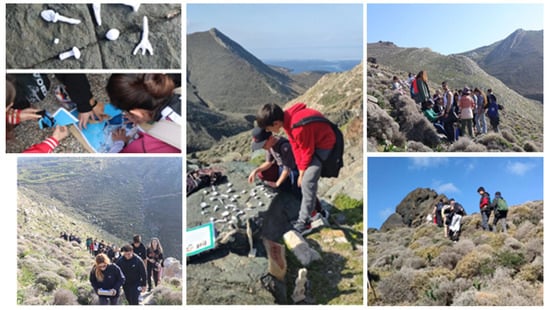
Figure 6.
Implementation of the educational program for primary and secondary school students at the eclogite site in Apano Meria.
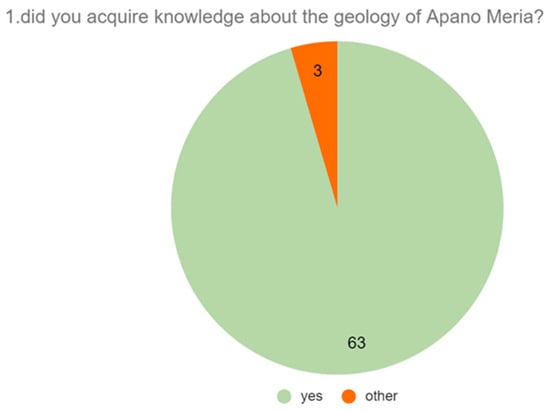
Figure 7.
Student responses to the evaluation of the educational program on Syros Island, highlighting its effectiveness in improving their geological knowledge of Apano Meria.
The depth of the knowledge gained by students on Syros Island who reported learning about the geology of Apano Meria varied (Figure 8). A total of 42 participants gave a score of 5 (meaning they learned a great deal), while 18 gave a score of 4. Four people made up a smaller group who rated their knowledge increase as moderate with a score of three. These findings show how well the program increased geological knowledge for most participants.
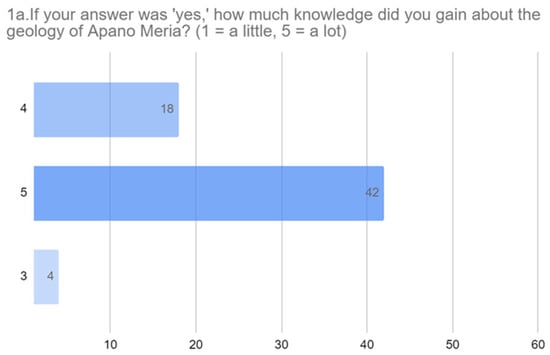
Figure 8.
Distribution of students’ self-assessed knowledge gain about Apano Meria geology after participating in the Syros Island educational program, indicating a high level of perceived learning outcomes.
The word cloud (Figure 9) depicts what participants understood most about Apano Meria’s geoheritage. The terms “rocks,” “rare,” “island,” “Aerolithos,” and “tectonic” are frequently used, indicating a strong retention of the area’s unique geological features, rare rock formations, and tectonic history. Other noteworthy terms, such as “plates,” “heritage,” “green,” and “eclogite,” indicate that participants gained a broad understanding of geological processes and the cultural significance associated with these formations.
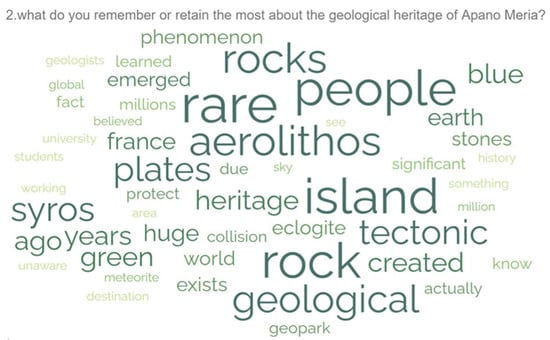
Figure 9.
Word cloud displaying the most memorable concepts participants indicated about the geoheritage of Apano Meria, highlighting significant terms like “rocks,” “rare,” “island,” “Aerolithos,” and “tectonic,” which indicate a high retention of both geological material and heritage relevance.
The program’s success in imparting geological knowledge is demonstrated by a pie chart (Figure 10), which indicates that 95.5% of respondents reported that they had acquired something from the rocks of Apano Meria. Only a small percentage of respondents expressed a different opinion, suggesting that there are minor opportunities for improvement in content delivery or engagement strategy.
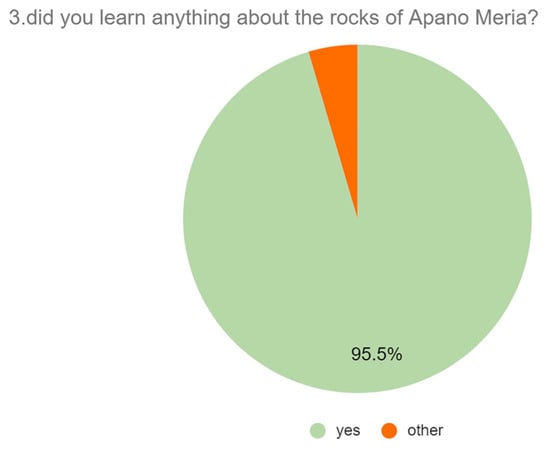
Figure 10.
The pie chart shows that 95.5% of participants reported learning something about the rocks of Apano Meria, highlighting the program’s effectiveness in communicating geological knowledge, with few responses indicating a need for further improvement in content delivery.
The bar chart (Figure 11) illustrates the extent of individuals’ comprehension of the rocks of Apano Meria. Most respondents expressed satisfaction with their knowledge acquisition; 32 selected “5” (a great deal) and 29 selected “4”. There were only two individuals who indicated that their level of knowledge was “3,” which indicates a moderate level of learning. This input demonstrates the program’s substantial impact on the enhancement of participants’ understanding of the geological characteristics of Apano Meria.
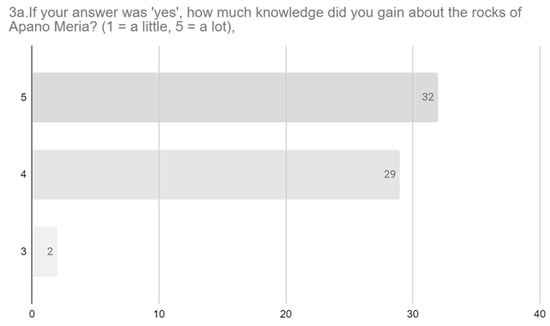
Figure 11.
Bar chart depicting participants’ self-assessed understanding of the rocks of Apano Meria.
The pie chart (Figure 12) below depicts participant responses to whether they learned about Apano Meria’s archaeology. A significant number of respondents (61 responses) answered “yes,” with only a small percentage (5 responses) choosing “other.” This illustrates the program’s effectiveness in imparting archaeological knowledge to most participants.
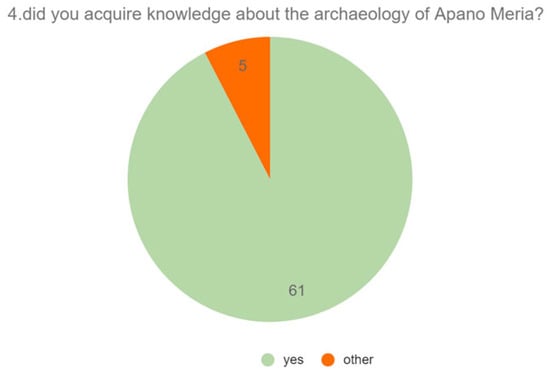
Figure 12.
Pie chart showing participants’ responses regarding the acquisition of knowledge about the archaeology of Apano Meria.
The graph in Figure 13 depicts what the participants learned about Apano Meria’s archaeology. The Cave of Pherecydes (the creator of the sundial) was mentioned by 56 participants, with Cycladic figurines receiving 51 responses. Forty-two participants mentioned Kastri’s Early Cycladic Period II settlement, while twenty-seven mentioned Early Cycladic I and II frying pans. Twenty participants referred to the Early Cycladic fortification settlement in Chalandriani, while eleven mentioned the Bronze Age metallurgical workshop. Finally, 5 individuals brought up additional subjects. Most people recalled Cycladic figurines and the Cave of Pherecydes.
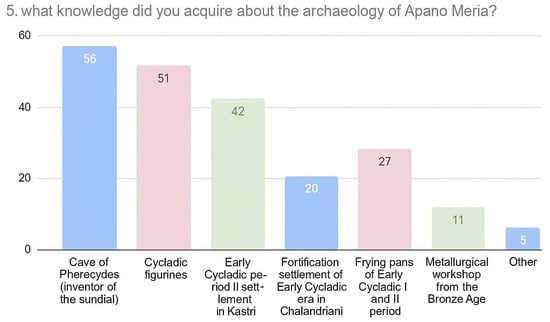
Figure 13.
Bar chart showing what participants remembered about the archaeology of Apano Meria. Most frequently mentioned were the Cave of Pherecydes (56 responses) and Cycladic figurines (51), followed by the Kastri settlement (42), frying pans (27), the Chalandriani fort (20), and the Bronze Age workshop (11).
The information that participants acquired regarding the history of Apano Meria is illustrated in Figure 14. The most frequently referenced topics were traditional agriculture, beekeeping, and livestock, with 59 mentions. Human activity in relation to the environment was the second most frequently referenced topic, with 57 responses. Byzantine period pirates and exiles and imprisonments in Giaros Island were each mentioned by 29 participants, while engraved rocks with inscriptions from 3000 BC at Grammata beach were observed by 48 participants. Maritime trade activity received the fewest responses (14), with only two participants mentioning other topics.
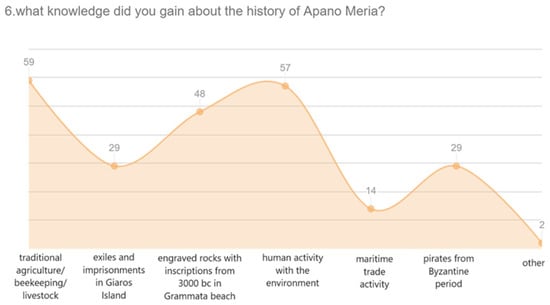
Figure 14.
Participants’ knowledge of Apano Meria’s history. Most participants recalled traditional practices (59) and human–environment interaction (57). Ancient inscriptions (48) and piracy and exile (29 each) followed, while maritime trade was least mentioned (14).
The following pie chart (Figure 15) shows that 90.9% of participants learned about the importance of creating a geopark in the area, while 9.1% did not.
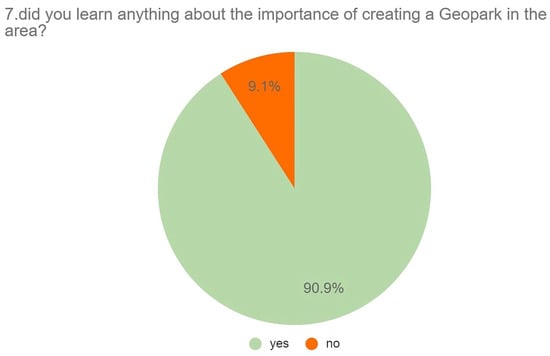
Figure 15.
Most participants (90.9%) recognized the importance of creating a geopark; few did not.
The word cloud in Figure 16 highlights that participants were most struck by terms like “area,” “geopark,” “protected,” “geological,” “community,” “island,” “heritage,” “tourism,” “natural,” “local,” “people,” and “preserved.” These keywords suggest a strong focus on conservation, local development, and the importance of establishing a geopark for both heritage and community benefit.
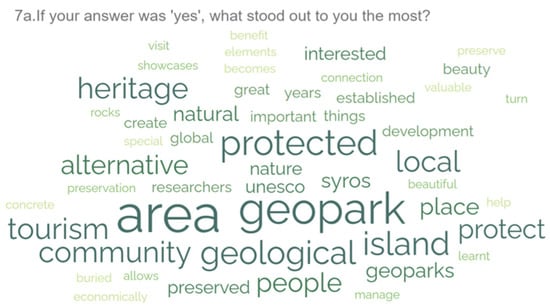
Figure 16.
The word cloud shows that key terms like “geopark,” “protected,” “heritage,” and “community” stood out, reflecting participants’ focus on conservation and local development.
Participants enjoyed aspects of the program such as “nature,” “route,” “walking,” “stretcher,” “activities,” “classmates,” “enjoyed,” “treasure,” and “view” the most (Figure 17). Other highlights include learning Morse code, discovering stones, solving riddles, and spending time with classmates. Terms like “georoute,” “fun,” and “hidden treasures” emphasize the engaging, interactive, and outdoor nature of the program.
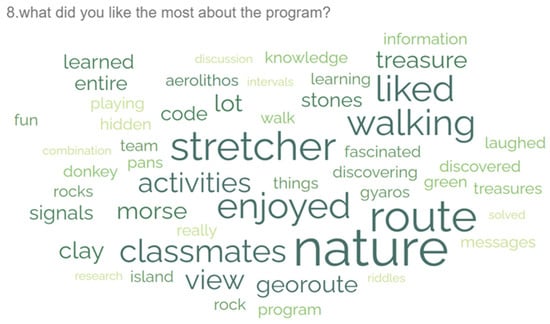
Figure 17.
Participants preferred “nature,” “walking,” “activities,” and “view” in the outdoor program, as well as solving puzzles and spending time with classmates.
Participants found some aspects of the program “challenging,” including the “walking,” “route,” and distinguishing “signals” or “colors.” Certain participants suggested minor improvements, like making letters more “recognizable,” providing more “shade,” or enhancing “puzzle” elements. However, many expressed satisfaction with the program, emphasizing “change nothing” as a recurring sentiment. Overall, feedback highlights both small difficulties and overall appreciation (Figure 18).
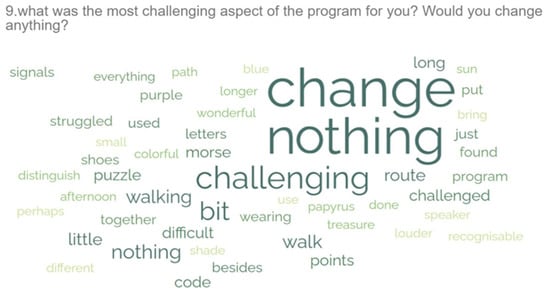
Figure 18.
Some participants found aspects of the program “challenging,” such as the “route,” “walking,” and identifying “signals” or “colors.” Suggestions included clearer letters, more shade, and improved puzzles, though many said “change nothing,” showing overall satisfaction.
Participants described feeling “happy,” “good,” and “relaxed” during the program, with words like “joy,” “great,” and “enthusiasm” also prominently featured. They enjoyed the experience, appreciated spending time with “classmates,” and found the program to be “fantastic” and “different.” While some mentioned feeling “tired” or “bored” at times, the overall sentiment was overwhelmingly positive, emphasizing the enjoyable and engaging nature of the activities (Figure 19).
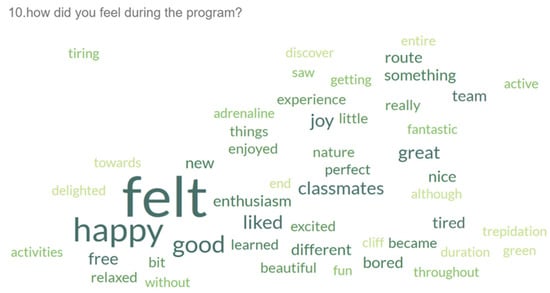
Figure 19.
Participants described feeling “happy,” “relaxed,” and “enthusiastic.” Words like “joy,” “great,” and “fantastic” highlighted their enjoyment, with only a few mentioning feelings “tired” or “bored”.
The chart below (Figure 20) shows that most participants (57) indicated they would participate in a similar program related to Apano Meria again, reflecting strong enthusiasm and interest in such initiatives. A smaller number of participants (8) selected “other,” possibly suggesting conditional participation or additional thoughts. Only one participant answered “no,” showing disinterest in future participation.
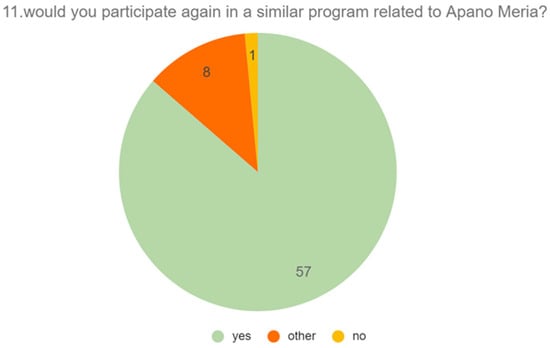
Figure 20.
Most participants (57) said they would join a similar program again, showing strong interest. Only one participant said “no,” and eight chose “other”.
The graph below (Figure 21) represents the gender distribution of participants in the program, with 34 female participants forming the largest group, followed by 31 males, and 1 participant identifying as a gender not listed in the options. This data shows a relatively balanced distribution between male and female participants, with a small representation of other gender identities.
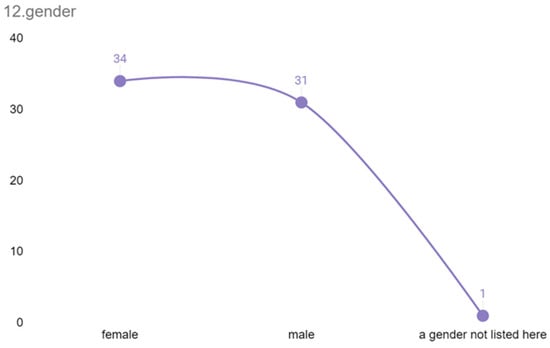
Figure 21.
Gender distribution included 34 females, 31 males, and 1 identifying as another gender, indicating a balanced participation.
3.2. Program Evaluation by Graduate Students of MA in Museum Studies as Part of the “Museum Education” Course
In this case, before implementing the program, students attended lectures on ecomuseums and on how educational programs are integrated into them. After reviewing examples of ecomuseums both at the European level (Ecomuseum of the Pays de Rennes, Ecomuseo della Canapa, Piemonte) and internationally (HirApano-cho, Asahi-machi, and Soga Ecomuseums), the case study of the Apano Meria in Syros Island was analyzed with the students. Additionally, after the lectures and before implementing the program, a mini workshop was conducted with the students regarding the characteristics of each age group (Appendix A included) and how important it is to take them into account during planning (Figure 22 and Figure 23).

Figure 22.
Key areas we focused on during the mini workshop prior to the educational program with graduate students as part of the “Museum Education” course. The workshop addressed the characteristics of each age group that should be considered when designing an educational museum program.
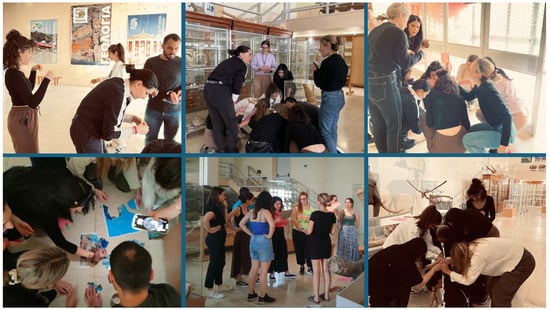
Figure 23.
Implementation of the educational program for postgraduate students of “Museum Studies” as part of the “Museum Education” course. The program took place at the Museum of Geology & Paleontology of the University of Athens.
The participants’ feedback on the educational program (Figure 24) was overwhelmingly positive, as reflected in their ratings across various aspects of the program. Starting with the educational workshop on age characteristics, 46.2% of participants rated it at the highest level (5), with an equal percentage giving it a 4 and only 7.7% rating it as 3. No participants rated it as 1 or 2, indicating a high level of satisfaction with this introductory session.
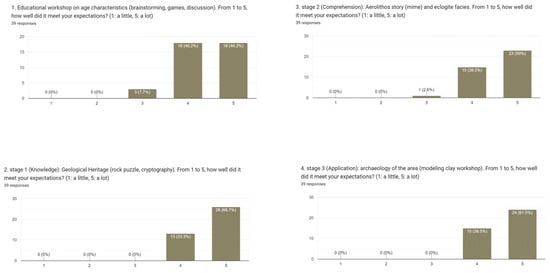
Figure 24.
Participant ratings show high satisfaction across all program stages, with Stages 1 (Knowledge), 2 (Comprehension), and 3 (Application) receiving the most top scores, while Stage 4 (Analysis) had slightly more moderate feedback.
For Stage 1 (Knowledge), which involved activities such as geological heritage puzzles and cryptography, 66.7% of participants rated it as 5, while 33.3% gave it a 4. There were no lower ratings, showing an overwhelmingly positive response to this segment of the program. Similarly, Stage 2 (Comprehension), which included the Aerolithos story and eclogite facies, was also well-received. Most participants (59%) rated it as 5, and 38.5% gave it a 4, with only a small percentage (2.6%) rating it as 3.
Moving to Stage 3 (Application), which involved a modeling clay workshop on the archaeology of the area, 61.5% rated it as 5, and the remaining 38.5% gave it a 4. No participants rated this stage lower, reflecting its effectiveness. In contrast, Stage 4 (Analysis), which focused on interpreting rock names using Morse code signals, saw slightly lower ratings. While 28.2% gave it the highest rating (5) and 59% rated it as 4, a small percentage (12.8%) rated it as 3. Although well-received overall, this stage had slightly more mixed feedback compared to others.
Based on Figure 25, the feedback for Stage 5 (Synthesis), which used augmented reality videos to explore the geology of Apano Meria, was mostly positive. Half of the participants (50%) rated it as 5, 33.3% gave it a 4, and 16.7% rated it as 3, suggesting a strong but slightly varied reception. Stage 6 (Evaluation), which employed an ecomuseological approach, garnered the highest level of satisfaction, with 74.4% rating it as 5 and 25.6% giving it a 4. There were no ratings below 4, underscoring the effectiveness of this stage.
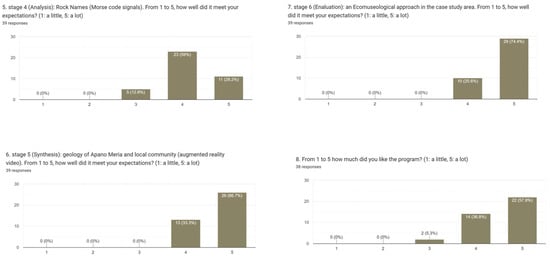
Figure 25.
Participant ratings for Stages 5 (Synthesis) and 6 (Evaluation) were highly positive, with Stage 6 receiving the highest satisfaction. Overall program and educational process ratings also reflect strong approval and engagement.
In terms of overall program satisfaction, 57.9% of participants rated the program as 5, while 36.8% gave it a 4. Only a small percentage (5.3%) rated it as 3, with no ratings of 1 or 2, highlighting participants’ general enthusiasm for the program. Similarly, 56.4% of participants rated the educational process as 5, and 38.5% gave it a 4. A minor 5.1% rated it as 3, again with no ratings of 1 or 2, reflecting a strong level of approval.
When it came to assessing whether the program achieved its goals (Figure 26), 48.7% rated it as 5, and an equal percentage gave it a 4. Only 2.6% rated it as 3, showing that most participants believed the program was effective in meeting its objectives. Lastly, the performance of the educator was highly rated, with 59% giving her a 5 and 35.9% a 4. A small percentage (2.6%) gave ratings of 3 and 2 each, but the majority expressed strong satisfaction with her role in the program.
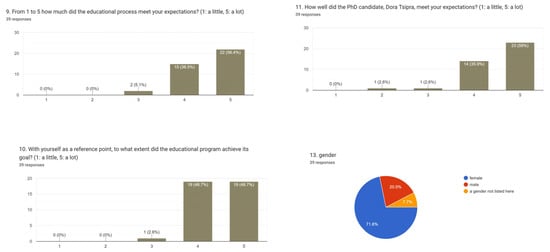
Figure 26.
Participants rated the program as successful in achieving its goals and expressed strong satisfaction with the educator’s performance. Graduate student feedback also reflected a predominantly positive evaluation, with most respondents identifying as female.
Finally, the pie chart in Figure 26 represents the gender distribution of the 39 graduate students who participated in the evaluation of the program as part of the “Museum Education” course in the MA in Museum Studies. Most respondents (71.8%) identified as female, while 20.5% identified as male. Additionally, 7.7% of participants identified with a gender not listed in the provided options. This distribution indicates a predominantly female representation among the respondents, which may reflect broader trends in museum studies and education-related fields.
Overall, the ratings indicate that the program was well-received across all its stages, with participants appreciating its structure, content, and implementation.
3.3. Exhibit Evaluation by Students and Teachers in Athens Science Festival 2023
The evaluation results of the exhibit at the Athens Science Festival 2023 indicate a highly positive reception from students and teachers. According to Figure 27, the majority of respondents (321) rated their appreciation of the exhibit at the highest level (5), followed by 136 giving it a 4, demonstrating strong engagement. Regarding the geological heritage of Syros, 89.9% reported having learned something new, with only a small percentage (3.9%) stating otherwise. Additionally, among those who acknowledged gaining knowledge, most (278) rated their learning experience at the highest level (5), further reinforcing the exhibit’s effectiveness in knowledge transfer. Similarly, 90.8% of respondents stated that they learned about the local community’s conservation efforts, showing that the exhibit successfully raised awareness about both geological heritage and environmental protection. These results highlight the exhibit’s strong educational impact and effectiveness in communicating key messages to its audience.
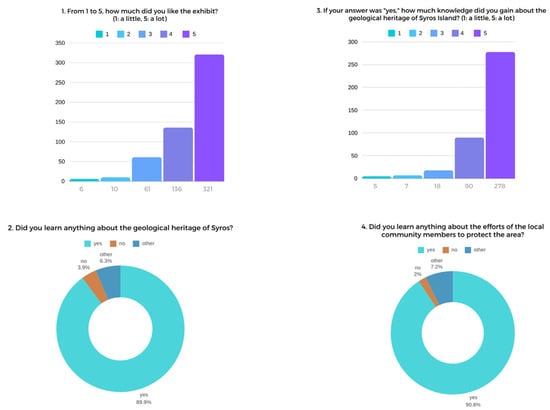
Figure 27.
Evaluation of the exhibit at the Athens Science Festival 2023 shows a high appreciation and learning outcomes among students and teachers, with most respondents reporting increased knowledge of Syros’ geological heritage and local conservation efforts.
Moreover, the evaluation results demonstrate the exhibit’s effectiveness in educating visitors on multiple aspects of the local heritage. Based on Figure 28, a significant majority (369 respondents) reported gaining substantial knowledge (rating 5) about the activities of local community members, with another 97 rating their learning experience at level 4. Regarding specific heritage aspects, 90.9% of respondents indicated they had learned something about the area’s history, while 92.6% had gained knowledge about its archaeology, highlighting the exhibit’s success in conveying cultural and historical information. Additionally, 89.8% of participants stated they learned about the local folklore, further emphasizing the exhibit’s ability to engage visitors with diverse cultural elements. The consistently high positive responses across all categories confirm the exhibit’s strong impact on raising awareness and disseminating valuable information about the region’s history, archaeology, and community involvement.
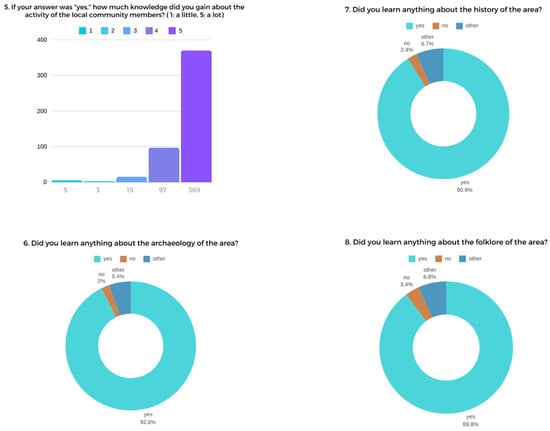
Figure 28.
The exhibit effectively educated visitors on local heritage, with most respondents reporting high levels of learning about community activities, history, archaeology, and folklore, demonstrating strong impact across cultural and historical themes.
Figure 29 presents the results of four evaluation questions about participants’ experiences and learning outcomes regarding the heritage of Apano Meria. The most popular topics were the Cave of Pherecydes, Cycladic figurines, and frying pans, as well as pirates from the Byzantine era, engraved rocks, exiles in Gyroulas, and settlement in Kastri. Many participants rated their knowledge gain at level 5, indicating a strong educational impact. A total of 92.4% of respondents expressed a high willingness to participate in future educational initiatives related to Apano Meria. Most participants were students (519), with a smaller group being teachers (23). The program’s focus on student engagement was highlighted, with a minor but relevant educator involvement. Overall, the figure demonstrates the strong appeal and educational effectiveness of the program, with particular interest in local archaeological features and widespread enthusiasm for continued participation.
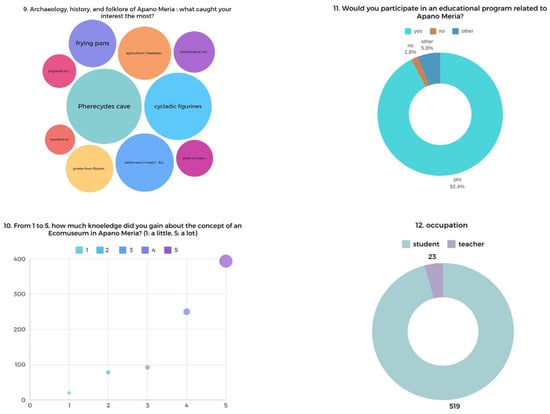
Figure 29.
Participants’ answers to the Apano Meria heritage exhibit. (Top left) A bubble chart of interest in Apano Meria’s archeology, history, and folklore, emphasizing the Cave of Pherecydes, Cycladic figurines, and frying pans. (Bottom left) On the dot plot, most respondents show the greatest degree (5) of self-assessed increase in their knowledge of ecomuseums. (Top right) Donut chart showing that 92.4% would engage in a related educational program. (Bottom right) Donut chart showing 23 teachers and 519 students’ jobs.
4. Discussion
In the context of geoheritage education, the results of this study highlight the excellent potential of outdoor museum education programs and experiential learning activities. Evaluations collected from a wide range of participants—graduate students in the MSc in Museum Studies and primary and secondary school students and teachers during the Athens Science Festival 2023—confirm the effectiveness of the program in fostering cognitive engagement, environmental awareness, and a deeper knowledge of Earth sciences.
Graduate students who participated in the “Museum Education” course applauded the interdisciplinary approach of the educational program, which skillfully combined scientific material with cultural, social, and community stories. Their qualitative comments underscored the program’s ability to make difficult geological concepts understandable, interesting, and emotionally resonant through storytelling, hands-on activities, and visual materials. Similarly, participants at the Athens Science Festival reacted quite positively. Quantitative studies revealed that most of the attendees—teachers and students—rated their experience with the exhibit and activities at the highest levels in terms of enjoyment and educational impact. Specifically in terms of the role of the local community in preserving natural and cultural heritage, over 90% of respondents said they had gained new knowledge about the geology, archaeology, history, and traditions of Syros.
These findings confirm the cognitive and emotional benefits of informal learning environments, in line with current studies. Through nature-based learning experiences, the gap between theoretical knowledge and practical engagement is bridged, thus promoting deeper understanding and memory. Studies by Wells [2] and Elliott & Davis [4] support this by suggesting that exposure to natural environments improves children’s ability to concentrate and encourages environmental responsibility. These results support the educational framework used in this project by confirming the use of experiential techniques and outdoor-centered spaces in this project.
The island of Syros, particularly the area of Apano Meria, provides an extremely valuable natural laboratory for Earth sciences education. Direct insight into global geodynamic processes and plate tectonics is provided by the unusual tectonic features and mineralogical paragenesis that occur within a subduction zone. The preservation and accessibility of these formations enhance the island’s suitability for geoeducation and geodiversity awareness initiatives. The initiative increases scientific literacy as well as a sense of place identity by connecting students’ learning experiences with this noteworthy geological landscape.
At the same time, the proposal to create a UNESCO World Geopark in Apano Meria is not only timely but also vital. Geoparks are centers for sustainable development, geotourism, and environmental education [8]. Participants in this project not only study Earth processes but also connect them with practical uses and social participation. The project bridges scientific research and public awareness by encouraging such links, thus fostering a culture of conservation and sustainability.
Especially remarkable is the execution of the pilot project at different educational levels, from primary schools to postgraduate studies. Changing the content and approach to fit the developmental stage of each group guaranteed that the learning experience was suitably interesting and difficult. All of this contributed to the high levels of satisfaction and learning outcomes that were achieved; students took part in interactive exhibits, museum activities, and field observations. These results reflect previous studies showing that informal education significantly increases participation and knowledge retention [1,3].
4.1. Future Implications and Challenges
The implementation of an integrated geoeducation program in Syros is a promising model for the promotion of geodiversity awareness, environmental awareness, and sustainable development. However, its long-term success and impact depends on addressing several important issues.
One of the main challenges is the integration of geological and environmental education into the formal school curriculum at all educational levels. Although the pilot project has attracted pupils and students from primary to tertiary education, scaling up this initiative requires institutional support, curriculum modification, and teacher training. Similar issues have been observed in previous geoeducation programs, where a lack of adequate teacher preparation and limited curriculum flexibility limited their effectiveness [46,47].
The Cyclades region suffers from a lack of educators with a geoscience background, making it difficult to consistently deliver high-quality, place-based education.
Access to the geosites of Apano Meria, despite their proximity, may also be logistically difficult for schools in urban areas or on other islands. According to Ballantyne & Packer [40], logistical difficulties are frequently a key obstacle to outdoor scientific study, despite its established educational benefits. If not properly addressed, problems such as transport costs, weather conditions, and lack of appropriate safety measures in the field could prevent greater participation.
Additionally, although Syros possesses a long geological history, in terms of infrastructure and interpretation, it currently lacks the necessary facilities to support geotourism and a structured educational use of its natural areas. The lack of signposted trails, interpretive signage, digital guides, or visitor centers in Apano Meria limits the potential impact of the project. Investing in interpretive services and a visitor infrastructure co-created by geologists, educators, and local agencies will help make the educational experience safe and effective [48,49].
Another difficulty is long-term community commitment and involvement. Although local community involvement has begun, maintaining long-term commitment and fostering a sense of local stewardship requires continued effort. Educational programs risk being seen as externally imposed or seasonal unless local schools, municipalities, cultural institutions, and residents are actively involved in building strong partnerships. This requires funding community-based educational programs that combine geoscience materials with local knowledge, livelihood tools, and cultural narratives.
The future of the program is quite dependent on securing stable funding sources. Much of the current implementation of the program depends on university resources and volunteer participation. Sustaining the program requires a more robust, long-term funding strategy—potentially through initiatives such as the creation of a UNESCO Global Geopark designation for Apano Meria, trail maintenance, signage development, teacher training, and guided field excursions. This could include EU funding (e.g., Interreg, Erasmus+), partnerships with national education authorities, and alliances with corporate sponsors interested in sustainable development and education.
Finally, the seasonality of participation—especially the concentration of events during school visits or festivals (e.g., the Athens Science Festival)—could jeopardize efforts to develop an educational program throughout the year. Increasing off-season educational tourism and diversifying the range would help to offset this difficulty.
4.2. Policy and Strategy Proposals for Strengthening the Geoeducation Program in Syros
To ensure the sustainability and institutionality of the geoeducation program in Syros, a series of targeted policy interventions and strategic actions are required. These should be based on cross-sectoral cooperation and strong local ownership. Indicatively, the following actions are proposed:
First, efforts should be made to formally integrate geoeducation, geodiversity awareness, and heritage interpretation into the national curriculum at all educational levels. This requires the integration of relevant activities in subjects such as geology, geography, natural sciences, local history, and education for sustainable development. Integrating outdoor education into the curriculum significantly enhances student engagement and environmental responsibility [40]. This, of course, requires the development of appropriate, approved teaching materials accompanied by a guide for teachers.
As far as Syros is concerned, a dedicated Center for Geoeducation and Geodiversity Interpretation should be established in Apano Meria or Ermoupoli (the capital of Syros Island), acting as a hub for school visits, workshops, guided fieldwork, and exhibition activities. In this context, digital learning resources will be provided, and the center will function as a platform for continuous professional development [50].
Efforts to officially designate selected geosites within Apano Meria as part of a UNESCO Global Geopark should be intensified. It is important to clarify that this proposal represents a local initiative currently in development, led by community stakeholders and supported by local institutions, and that Apano Meria has not yet been designated as a UNESCO Global Geopark. This process should be supported by regional and municipal authorities and include a comprehensive nomination dossier highlighting elements of geoconservation, environmental education, and sustainable territorial development. UNESCO Global Geoparks are internationally recognized frameworks that serve to combine conservation, education and sustainable development [8,51].
Training programs for teachers, museum educators, and local guides should be established in collaboration with universities and research institutions with recognized accreditation, ensuring the delivery of high quality scientific geoeducation content aligned with pedagogical best practices [52].
A strong financial framework needs to be developed for the success of the program. Currently dependent on university and volunteer resources, the initiative’s long-term sustainability will require diversified funding streams, including EU grants, partnerships with educational authorities, and corporate sponsorship linked to sustainability and education priorities [53].
Generally, geoeducation and geotourism should be integrated into the broader agenda of sustainable tourism development on the island and engage local businesses to design educational tourism packages, promote off-season visits, and, ultimately, establish Syros as an experiential learning destination. Moreover, according to [54], geotourism supports both heritage conservation and local economies.
A continued involvement of the local community is essential to ensure the success of the project. This requires strong partnerships with local schools, municipalities, cultural associations, and residents. Educational initiatives should reflect both the scientific content and local traditions and values, thus ensuring ongoing support from the community [55].
Finally, the development of a digital platform that offers virtual tours, downloadable educational content, documentation of activities, and options for remote participation will enhance accessibility and promotion of the project, significantly increasing its visibility and outreach potential.
5. Conclusions
The present study focuses on the educational, social, and geoconservation-related benefits of the implementation of an integrated geoeducation program in Syros, in the Aegean Sea, and specifically in Apano Meria. The project successfully increased environmental awareness, scientific literacy, and appreciation for the island’s unique geological heritage through museum-based learning, experiential field activities, and interdisciplinary approaches involving students from primary to tertiary education.
Evaluation data collected during the pilot projects, including participation in the Athens Science Festival and evaluations by graduate students, show that participants are highly satisfied, engaged, and have a cognitive impact. Both students and teachers praised the structure and content of the program, particularly its ability to combine theoretical knowledge with practical geological observation and outdoor learning. These findings support the widely held belief that informal, nature-based education improves learning outcomes and environmental responsibility.
Syros, and particularly the geologically important Upper Meria, is an excellent location for geoconservation education. Its tectonic structures and its mineralogy are globally important examples of subduction processes, making it not only a scientifically important site but also an ideal environment for educational programs and geotourism development. The proposed initiative to create a UNESCO World Geopark in this area will enhance these benefits by institutionalizing the conservation and educational use of the island’s natural resources.
However, this study identified critical issues that need to be addressed to ensure the long-term sustainability and impact of the project. These include the need for consistent funding, integration into formal educational initiatives, geoscience teacher training, infrastructure improvements, and increased community involvement. Ignoring these fundamental issues will hinder long-term implementation and expansion.
The Syros geoeducation program overall exemplifies a consistent approach to using local geological history as a platform for interdisciplinary education, community engagement, and sustainability. The success of such programs is determined not only by their educational design but also by the amount and quality of collaboration between local communities, government officials, scientists, and educators. By combining education with geoconservation and cultural heritage, this project contributes to the development of environmentally aware people and the preservation of Syros’ unique geological heritage for future generations.
Author Contributions
Conceptualization, T.T. and H.D.; methodology, T.T.; formal analysis, T.T.; investigation, T.T.; resources, H.D.; data curation, T.T.; writing—original draft preparation, T.T.; writing—review and editing, H.D.; supervision, H.D. All authors have read and agreed to the published version of the manuscript.
Funding
This research received no external funding.
Data Availability Statement
The data supporting the findings of this study consist of qualitative observations and evaluation outcomes from the implementation of a geoeducational program. These data are available from the corresponding author upon reasonable request. They are not publicly available due to privacy and ethical restrictions involving participant information.
Acknowledgments
The authors would like to thank the anonymous reviewers for their constructive comments and suggestions. Special thanks are also extended to Georgia Gkaniatsa for her valuable participation in the field work and the evaluation activities during the Athens Science Festival.
Conflicts of Interest
The authors declare no conflicts of interest.
Appendix A. Educational Museum Program: Treasure Hunt Game on Cyanoschist Types: “Secret Code: Blue Diamond”
Appendix A.1. Aim
The aim is for students to get in touch with mineral rocks, develop their critical thinking, and gain an awareness-raising attitude towards environmental issues. Expressing their own creativity, they can lay the foundations for understanding the creation and formation of rocks over the centuries and appreciate their correlation with important issues of geological heritage and culture.
Appendix A.2. Program Identity
- Location: indoor and outdoor exhibition space (or at a point of the geodetic route);
- Duration: 2 h;
- Age group: 7–11 years old;
- School group: typical school class;
- Grades: from 2nd to 5th grade of elementary school;
- Number of children: up to 30;
- Number of coordinators: at least 1 coordinator and 1 assistant;
- Exhibits to be used: glaucophane and eclogites (Figure A1).
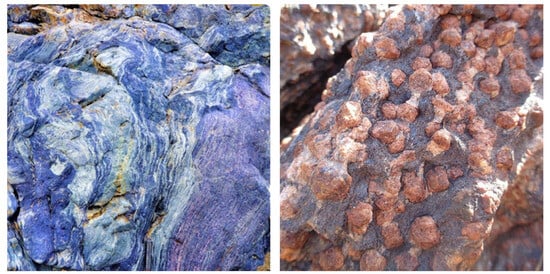
Figure A1.
Source: https://twitter.com/chikitoo/status/1035981609583955968?lang=ar (accessed on 20 March 2024), https://commons.wikimedia.org/wiki/File:Eclogite_of_Syros.JPG (accessed on 20 March 2024).
- Characteristics of children aged 7–11 years old (psychosocial, physical, and cognitive development) [56,57]:
- Imitation of patterns;
- Fine motor skills—ability to sort and organize ideas and objects;
- Need for cooperation and mutual understanding;
- Interest in team games and need for intense physical activity;
- Developing conscience, morality, and a value judgment system;
- Beginning to be self-critical and need to alternate each activity;
- Existence of imagination, combined with a developed realistic view;
- Performance in fantasy role-playing games and in rule-based games;
- Readiness for learning and visual–spatial skills;
- Interest in experiential learning/practicing skills to become better;
- Interest in finding out how things work, in working and completing their work;
- Preference for participating in a group as an active member rather than just being a spectator;
- Desire for creativity and ingenuity;
- Social interaction with peers (mostly of the same sex);
- Much more awareness of choosing words to share feelings;
- Need for reward;
- Willingness to do things well and a desire to succeed and not make mistakes.
Appendix A.3. Method
The program will be based on the principles of “learning by doing” and of teamwork (Bloom’s taxonomy: knowledge–comprehension–application–analysis–evaluation).
Appendix A.4. Targets
- To acquire a positive attitude towards the geological wealth of the region.
- To understand through experiential learning how the values of creativity and ingenuity are transformed into behaviors and attitudes in life.
- To be more connected as a team, to strengthen the cooperation and solidarity among the team, and to build a climate of trust and security.
Appendix A.5. Description and Implementation
The whole plot of the game can be based on a myth in order to keep the interest of the children undiminished so that they can act in different roles (role playing). The goal is to discover the “treasure” of the exhibition, going through various stages from which they will obtain an element that will bring them closer and closer to the solution of the mystery.
Appendix A.5.1. Myth
Introduction: 5 min
Two secret agents appear and explain to the children why they asked for their help. Somewhere in the place, there is a rock, which hides a great treasure. But they do not know what rock it is… All they have at their disposal is this map and this old book that they dug up from a trunk in the library warehouse and they know it is important. They ask the children if they want to help them discover the treasure together. After their positive answer, the secret mission begins.
Stage A: 10 min (Knowledge), Method: Kinetic Game of Cooperation and Observation
The children are directed to the first point of the map. There are pieces of a puzzle scattered all over the place. The children are invited to discover the pieces and put them together. Each piece bears information about the “blue diamond” (characteristics, name, formation periods, etc.). When they put them together and the picture is complete, it is hung in a central point, so that all the features are visible.
Finally, the secret agent surprisedly announces that a clue has appeared in the book and encourages the children to continue.
Objectives: enhancing observation, enhancing imagination, taking initiatives, satisfying learning readiness
Stage B: 20 min (Understanding), Method: Dramatization
The clue in the book is a story about the chronological stages that preceded the formation of the rocks. The secret agent encourages the children to depict with their bodies without speaking (mime) the scenes that are narrated in the story. For example: “Both cyanoblasts and electrolytes were created in the middle of an ocean 80 million years ago, shortly after the extinction of the dinosaurs. However, they did not have the look they have today. They acquired this special beauty in colors and minerals first after travelling for 100 km deep in the earth and then being ‘transformed’ by the high temperatures and pressures that prevailed there, which situation was like a volcano with lava and then emerged on the surface.” Presentation: 10 min. Then, another clue appears in the book (!!). The agents reward the children as they believe they are very close to solving the mystery…
Objectives: Satisfaction of learning readiness, satisfaction of the need to participate in a group, satisfaction of the need for physical activity, satisfaction of the need for reward from adults.
Stage C: 30 min (Application), Method: Workshop
At the third point indicated on the map, there are various materials scattered (cold clay, modeling clay, colors, etc.). Near the place where the “blue diamond” was discovered, in Kastri, objects from the Prehistoric and Early Cycladic era were found (Figure A2). The children are encouraged to make their own tool, jewelry, or statuette with these materials. The third clue also appears in the book. The children join the three points on the map together and discover the place where the rock is exhibited.
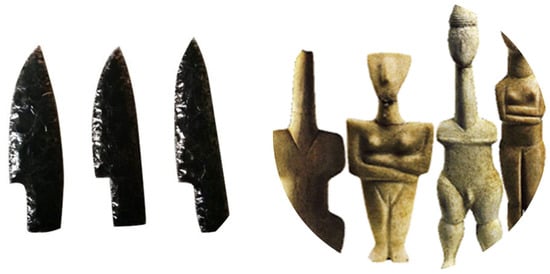
Figure A2.
Source: https://2.bp.blogspot.com/_FdWs7pMeuqs/SFF5yp-I6dI/AAAAAAAAAFI/a5eYH3jLfoo/s320/1abc8b.gif (accessed on 16 June 2025).
Objectives: Satisfaction of learning readiness, development of creativity and fine movement, development of observation, perception, analysis, logical thinking, and cognitive skills in relation to the project.
Stage D: 35 min (Analysis), Method: Game of Cooperation and Trust, Dramatization
The children arrive at the display cases where the “blue diamond” is exhibited, and the agents are surprised to announce that they have managed to discover the rocks which hide the “treasure”. They are the glaucophane and the eclogites! The children are asked to observe the stones carefully for a few minutes and gather as much information as they can. They are then divided into two groups. Each one prepares a presentation of the story that has been given to them and presents it to the others as frozen images (tableau vivant) (e.g., “About 170 years ago, in 1845, the German geologist Hausmann, while wandering on the island, discovered a mineral with an impressive electric blue colour in Syros. Then he came up with the idea of calling it “glaucous”. the split stones of the island that contained glaucous, were named cyanoschists…”, etc.)
The agents ask the children whether they can imagine what the treasure of the rock might be, and they write the children’s ideas down on a piece of paper (brainstorming).
Then they all discuss together how important it is to protect these rocks and to highlight the sites with this heritage.
Objectives: Development of observation, development of imagination in combination with realistic thinking, development of cognitive skills in relation to the project, development of physical movement, development of empathy.
Appendix A.6. Evaluation and Support Material
Evaluation: 5 min—evaluation form.
Closing: 5 min—awarding a participation souvenir.
Support Material
Introduction: A map, a book.
Stage a: A printed picture cut into pieces (puzzle) bearing the listed characteristics, a display board (for the picture).
Stage c: Cold clay, modeling clay, pencils, paints (tempera, finger paints), brushes, plastic cups, water, a tarpaulin.
Stage d: A sheet or a large piece of cloth for frozen images (tableau vivant).
Evaluation: Forms, pencils, markers.
Closing: A participation souvenir.
Appendix B. Evaluation of the Educational Museum Program “Secret Code-‘Blue Diamond’”
This evaluation concerns the museum educational program that took place on 7 February 2024 at the Paleontology Museum of the University of Athens, as part of the course “Museum Education” of the MSc in Museum Studies, and it constitutes an important tool for feedback regarding both educational topics and their delivery methods.
| Please indicate (√) the extent to which each of the following met your expectations or how much you liked it: | |||||
| 1: Very little, 2: Little, 3: Moderately, 4: Quite a lot, 5: A lot | 1 | 2 | 3 | 4 | 5 |
| 01. Educational workshop on age characteristics (brainstorming, games, discussion). From 1 to 5, how well did it meet your expectations? | ☐ | ☐ | ☐ | ☐ | ☐ |
| 02. Stage 1 (Knowledge): Geological heritage (rock puzzle, cryptography). From 1 to 5, how well did it meet your expectations? | ☐ | ☐ | ☐ | ☐ | ☐ |
| 03. Stage 2 (Comprehension): Aerolithos story (mime) and eclogite facies. From 1 to 5, how well did it meet your expectations? | ☐ | ☐ | ☐ | ☐ | ☐ |
| 04. Stage 3 (Application): Archaeology of the area (modeling clay workshop). From 1 to 5, how well did it meet your expectations? | ☐ | ☐ | ☐ | ☐ | ☐ |
| 05. Stage 4 (Analysis): Rock names (Morse code signals). From 1 to 5, how well did it meet your expectations? | ☐ | ☐ | ☐ | ☐ | ☐ |
| 06. Stage 5 (Synthesis): Geology of Apano Meria and local community (augmented reality video). From 1 to 5, how well did it meet your expectations? | ☐ | ☐ | ☐ | ☐ | ☐ |
| 07. Stage 6 (Evaluation): An ecomuseological approach in the case study area. From 1 to 5, how well did it meet your expectations? | ☐ | ☐ | ☐ | ☐ | ☐ |
| 08. From 1 to 5, how much did you like the program? | ☐ | ☐ | ☐ | ☐ | ☐ |
| 09. From 1 to 5, how much did the educational process meet your expectations? | ☐ | ☐ | ☐ | ☐ | ☐ |
| 10. With yourself as a reference point, to what extent did the educational program achieve its goal? | ☐ | ☐ | ☐ | ☐ | ☐ |
| 11. How well did the educator meet your expectations? | ☐ | ☐ | ☐ | ☐ | ☐ |
| 12. Something you want to add (e.g., something you liked or something that was challenging for you)? Answer | |||||
| 13. Gender? Female Male A gender not listed here | |||||
References
- Turkmen, H. The Effect of Scientific Events in Shopping Mall on Children’s Learning and Social Interaction: Case of Life Cycle of Butterfly & Formation of Rainbow. Int. J. Pedagog. Soc. Stud. 2022, 7, 41–52. [Google Scholar]
- Elliott, S.; Davis, J. Exploring the Resistance: An Australian Perspective on Educating for Sustainability in Early Childhood. Int. J. Early Child. 2009, 41, 65–77. [Google Scholar] [CrossRef]
- Lind, K.K. Science in Early Childhood: Developing and Acquiring Fundamental Concepts and Skills; Opinion Papers, Speeches/Meeting Papers; ERIC: Washington, DC, USA, 1998. Available online: https://files.eric.ed.gov/fulltext/ED418777.pdf (accessed on 12 December 2024).
- Wells, N.M. At Home with Nature: Effects of “Greenness” on Children’s Cognitive Functioning. Environ. Behav. 2000, 32, 775–795. [Google Scholar] [CrossRef]
- Drinia, H.; Tsipra, T.; Panagiaris, G.; Patsoules, M.; Papantoniou, C.; Magganas, A. Geological Heritage of Syros Island, Cyclades Complex, Greece: An Assessment and Geotourism Perspectives. Geosciences 2021, 11, 138. [Google Scholar] [CrossRef]
- McKeever, P.J.; Zouros, N.C. Geoparks: Celebrating Earth Heritage, Sustaining Local Communities. Episodes 2005, 28, 274–278. [Google Scholar] [CrossRef]
- Eder, W.; Patzak, M. Geoparks—Geological Attractions: A Tool for Public Education, Recreation and Sustainable Economic Development. Episodes 2004, 27, 162–164. [Google Scholar] [CrossRef]
- Zouros, N.C. The European Geoparks Network: Geological Heritage Protection and Local Development. Episodes 2004, 27, 165–171. [Google Scholar] [CrossRef]
- Tsipra, T.; Drinia, H. Geocultural Landscape and Sustainable Development at Apano Meria in Syros Island, Central Aegean Sea, Greece: An Ecomuseological Approach for the Promotion of Geological Heritage. Heritage 2022, 5, 2160–2180. [Google Scholar] [CrossRef]
- Santoso, T.B. The benefit of outdoor activity for child development. Ann. Physiother. Occup. Ther. 2023, 5, 1–10. [Google Scholar] [CrossRef]
- Fjørtoft, I. The Natural Environment as a Playground for Children: The Impact of Outdoor Play Activities in Pre-Primary School Children. Early Child. Educ. J. 2001, 29, 111–117. [Google Scholar] [CrossRef]
- Herrington, S.; Studtmann, K. Landscape Interventions: New Directions for the Design of Children’s Outdoor Play Environments. Landsc. Urban Plann. 1998, 42, 191–205. [Google Scholar] [CrossRef]
- Williams, R.; Higgins, P.; Humberstone, B.; Loynes, C. (Eds.) Outdoor, Adventure and Experiential Learning: A Wealth of European Concepts; European Institute for Outdoor Adventure Education: Marburg, Germany, 2001. [Google Scholar]
- White, R.; Stoecklin, V. Children’s Contact with the Outdoors and Nature: A Focus on Educators and Educational Settings. Child. Environ. 1998, 15, 1–14. [Google Scholar]
- Wilson, E.O. Biophilia; Harvard University Press: Cambridge, MA, USA, 1984. [Google Scholar]
- Wilson, R.A. The Wonders of Nature: Honoring Children’s Ways of Knowing. Early Child. News 1997, 9, 16–19. [Google Scholar]
- Lewis, C.A. Green Nature, Human Nature: The Meaning of Plants in Our Lives; University of Illinois Press: Urbana, IL, USA, 1996. [Google Scholar]
- Francis, M. Childhood’s Garden: Memory and Meaning of Gardens. Child. Environ. 1995, 12, 1–16. [Google Scholar]
- Sobel, D. Beyond Ecophobia: Reclaiming the Heart in Nature Education; Orion Society: Great Barrington, MA, USA, 1996. [Google Scholar]
- Hart, R. Children’s Participation: The Theory and Practice of Involving Young Citizens in Community Development and Environmental Care; Earthscan Publications Ltd.: London, UK, 1997. [Google Scholar]
- Moore, R.C. The Need for Nature: A Childhood Right; Natural Learning Initiative, North Carolina State University: Raleigh, NC, USA, 1996; Available online: https://www.jstor.org/stable/29767032 (accessed on 16 June 2025).
- Vergo, P. (Ed.) The New Museology; Reaktion Books: London, UK, 1989. [Google Scholar]
- ICOM. Definition of Museum, 2022. ICOM: International Council of Museums. Available online: https://icom.museum/en/resources/standards-guidelines/museum-definition/ (accessed on 16 June 2025).
- de Varine, H. L’Initiative Communautaire: Recherche et Expérimentation, W/MNES, ed.; Presses Universitaires de Lyon: Lyon, France, 1991. [Google Scholar]
- Rivière, G.H. The ecomuseum—An evolutive definition. Mus. Int. 1985, 37, 182–184. [Google Scholar] [CrossRef]
- Kern, L. Feminist City: Claiming Space in a Man-Made World; Verso Books: London, UK, 2020. [Google Scholar]
- Sandercock, L. Towards Cosmopolis: Planning for Multicultural Cities; Wiley-Blackwell: Chichester, UK, 2003. [Google Scholar]
- Kotowski, A.J.; Cisneros, M.; Behr, W.M.; Stockli, D.F.; Soukis, K.; Barnes, J.D.; Ortega-Arroyo, D. Subduction, Underplating, and Return Flow Recorded in the Cycladic Blueschist Unit Exposed on Syros, Greece. Tectonics 2022, 41, e2020TC006528. [Google Scholar] [CrossRef]
- Laurent, V.; Jolivet, L.; Roche, V.; Augier, R.; Scaillet, S.; Cardello, G.L. Strain Localization in a Fossilized Subduction Channel: Insights from the Cycladic Blueschist Unit (Syros, Greece). Tectonophysics 2016, 672, 150–169. [Google Scholar] [CrossRef]
- Jolivet, L.; Brun, J.-P. Cenozoic Geodynamic Evolution of the Aegean. Int. J. Earth Sci. 2010, 99, 109–138. [Google Scholar] [CrossRef]
- Trotet, F.; Jolivet, L.; Vidal, O. Tectono-Metamorphic Evolution of Syros and Sifnos Islands (Cyclades, Greece). Tectonophysics 2001, 338, 179–206. [Google Scholar] [CrossRef]
- Keiter, M.; Ballhaus, C.; Tomaschek, F. A New Geological Map of the Island of Syros (Aegean Sea, Greece): Implications for Lithostratigraphy and Structural History of the Cycladic Blueschist Unit; Geological Society of America Special Papers; Geological Society of America: Boulder, CO, USA, 2011. [Google Scholar] [CrossRef]
- Keiter, M.; Piepjohn, K.; Ballhaus, C.; Lagos, M.; Bode, M. Structural development of high-pressure metamorphic rocks on Syros island (Cyclades, Greece). J. Struct. Geol. 2004, 26, 1433–1445. [Google Scholar] [CrossRef]
- Philippon, M.; Brun, J.-P.; Gueydan, F. Tectonics of the Syros blueschists (Cyclades, Greece): From subduction to Aegean exten-sion. Tectonics 2011, 30, TC4016. [Google Scholar] [CrossRef]
- Schumacher, J.C.; Brady, J.B.; Cheney, J.T.; Tonnsen, R.R. Glaucophane-bearing Marbles on Syros, Greece. J. Pet. 2008, 49, 1667–1686. [Google Scholar] [CrossRef]
- Anderson, L.W.; Krathwohl, D.R. A Taxonomy for Learning, Teaching, and Assessing: A Revision of Bloom’s Taxonomy of Educational Objectives; Longman: New York, NY, USA, 2001. [Google Scholar]
- Kolb, D.A. Experiential Learning: Experience as the Source of Learning and Development; Prentice Hall: Englewood Cliffs, NJ, USA, 1984. [Google Scholar]
- Dewey, J. Experience and Education; Macmillan: New York, NY, USA, 1938. [Google Scholar]
- Rickinson, M.; Dillon, J.; Teamey, K.; Morris, M.; Choi, M.Y.; Sanders, D.; Benefield, P. A Review of Research on Outdoor Learning; National Foundation for Educational Research: Slough, UK; King’s College London: London, UK, 2004. [Google Scholar]
- Ballantyne, R.; Packer, J. Introducing a Fifth Pedagogy: Experience-Based Strategies for Facilitating Learning in Natural Environments. Environ. Educ. Res. 2009, 15, 243–262. [Google Scholar] [CrossRef]
- Hein, G.E. Learning in the Museum; Routledge: London, UK, 1998. [Google Scholar]
- Braund, M.; Reiss, M. Towards a More Authentic Science Curriculum: The Contribution of Out-of-School Learning. Int. J. Sci. Educ. 2006, 28, 1373–1388. [Google Scholar] [CrossRef]
- Dillon, J.; Rickinson, M.; Teamey, K.; Morris, M.; Choi, M.Y.; Sanders, D.; Benefield, P. The Value of Outdoor Learning: Evidence from Research in the UK and Elsewhere. Sch. Sci. Rev. 2006, 87, 107–111. [Google Scholar]
- Mogk, D.W.; Goodwin, C. Learning in the Field: Synthesis of Research on Thinking and Learning in the Geosciences. In Earth and Mind II: A Synthesis of Research on Thinking and Learning in the Geosciences; Kastens, K.A., Manduca, C.A., Eds.; Geological Society of America: Boulder, CO, USA, 2012; pp. 131–163. [Google Scholar] [CrossRef]
- Orion, N.; Hofstein, A. Factors That Influence Learning during a Scientific Field Trip in a Natural Environment. J. Res. Sci. Teach. 1994, 31, 1097–1119. [Google Scholar] [CrossRef]
- King, C. Geoscience Education: An Overview. Stud. Sci. Educ. 2008, 44, 187–222. [Google Scholar] [CrossRef]
- Orion, N. The Relevance of Earth Science for Informed Citizenship: Its Potential and Fulfillment. In Contextualizing Teaching to Improving Learning; Liete, L., Dourado, L., Morado, S., Eds.; Nova Science Publishers, Inc.: New York, NY, USA, 2017; pp. 41–56. [Google Scholar]
- Zouros, N.; Martini, G. Geoparks: A Tool for Education, Recreation and Geotourism. Episodes 2003, 26, 165–171. [Google Scholar]
- Gray, M. Geodiversity: Valuing and Conserving Abiotic Nature; Wiley-Blackwell: Oxford, UK, 2013. [Google Scholar]
- Falk, J.H.; Dierking, L.D. Learning from Museums, 2nd ed.; Rowman & Littlefield: Lanham, MD, USA, 2018. [Google Scholar]
- Farsani, N.T.; Coelho, C.; Costa, C. Geotourism and Geoparks as Novel Strategies for Socio-economic Development in Rural Areas. Int. J. Tour. Res. 2011, 13, 68–81. [Google Scholar] [CrossRef]
- Corney, G. Education for Sustainable Development: An Empirical Study of the Tensions and Challenges Faced by Geography Student Teachers. Int. Res. Geogr. Environ. Educ. 2006, 15, 224–240. [Google Scholar] [CrossRef]
- Tilbury, D.; Wortman, D. Engaging People in Sustainability; Commission on Education and Communication; IUCN: Gland, Switzerland, 2004. [Google Scholar]
- Newsome, D.; Dowling, R. Setting an Agenda for Geotourism. In Geotourism: The Tourism of Geology and Landscape; Newsome, D., Dowling, R., Eds.; Goodfellow Publishers: Oxford, UK, 2010; pp. 1–12. [Google Scholar]
- Reed, M.S. Stakeholder Participation for Environmental Management: A Literature Review. Biol. Conserv. 2008, 141, 2417–2431. [Google Scholar] [CrossRef]
- Waters, T. Schooling, Childhood, and Bureaucracy. In Bureaucratizing the Child; Palgrave Macmillan: New York, NY, USA, 2012; pp. 83–87. [Google Scholar]
- Facilitating the Healthy Development of Children 7–11 Years; YMCA Discovery Book. Available online: https://www.cliffsnotes.com/study-guides/psychology/development-psychology/physical-cognitive-development-age-711/physical-development-age-711 (accessed on 16 April 2025).
Disclaimer/Publisher’s Note: The statements, opinions and data contained in all publications are solely those of the individual author(s) and contributor(s) and not of MDPI and/or the editor(s). MDPI and/or the editor(s) disclaim responsibility for any injury to people or property resulting from any ideas, methods, instructions or products referred to in the content. |
© 2025 by the authors. Licensee MDPI, Basel, Switzerland. This article is an open access article distributed under the terms and conditions of the Creative Commons Attribution (CC BY) license (https://creativecommons.org/licenses/by/4.0/).